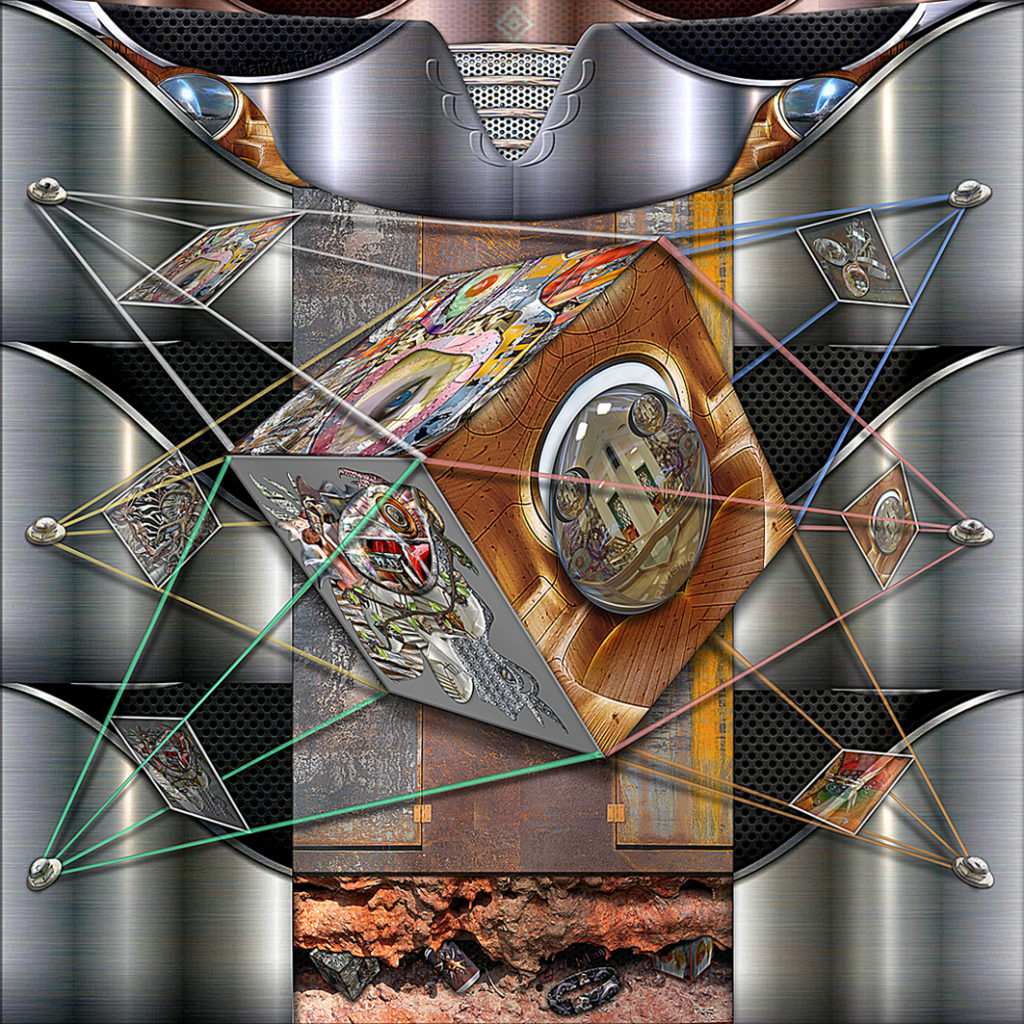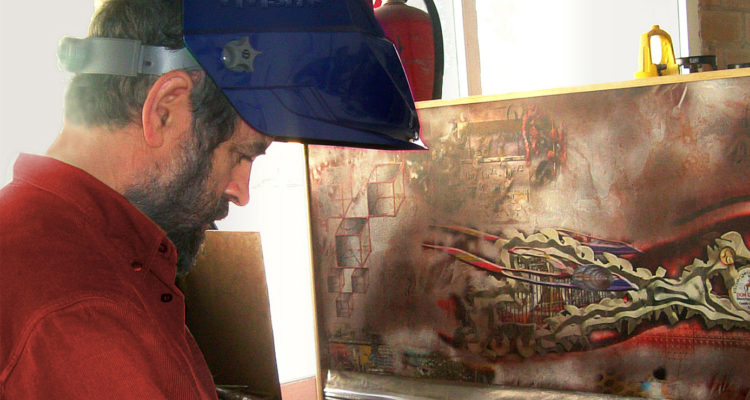“I am me and my circumstances.”
Paul Zimmerman in conversation with Ramon Rivas
Paul Zimmerman: How did you develop interest in art?
Ramon Rivas: Art was included in my family environment. My grandfather painted extraordinary murals, mainly with hunting motifs. My mother was a painter of landscapes, flowers and children’s themes. My father, whose company was dedicated to repairing, restoring, building, painting and decorating all types of vehicles. All this source of art, was present in me since I was a child, and I participated during the school vacations, as an assistant in the works made by my relatives and their companies. This beginning was the base to continue and consolidate my artistic proposal, which has been complemented with the multidisciplinary influence of my professional activities; in sports, music, engineering and inventions.
PZ: What is Rivismo?
RR: It is my personal direction in the world of art. The use of “Experiential Brushstrokes”, constitute the basis of Rivismo. These brushstrokes carry differentiating concepts, such as The strong and the weak, From a part to the whole, From a part to a whole, Experiential balance, Experiential empathy in materials, Reassignment of roles and functions, among others.
Rivismo, gives protagonism and freedom to material and immaterial elements, so that they participate in equal conditions as if they were people. Material, objects and mathematical or physical expressions, among others, that participate in functions and feelings proper to human relations, intervene. From here, the application of the differentiating concepts mentioned above is born. The application of these brushstrokes to the work scenario creates the switch that connects the artist with the observers of his work. In this case, the exchange of energy leads to a state with the intention of provoking surprise to the viewer. The final objective is to bring creativity, novelty, imagination and freshness to today’s art.
PZ: What is your artistic process? How do you create your paintings?
RR: First of all, I treat my work as if it were an engineering project. I establish the starting point and the end I want to reach. Therefore, most of the work is established before I start it. My brain acts like a computer on whose hard drive my family and multi-professional experiences are stored. In this way, I design the architectural structure to create a theme. If, for example, it is a scientific theme, I apply mathematical, physical properties, etc., and integrate them into the scenario. The application of experiential brushstrokes, of pictorial and digital material on supports; canvas, aluminum, plastics, oxidized iron, etc., will create the work, always within a state of balance in the composition, textures, coloring, etc.
PZ: How did your practice change over time?
RR: Although I have made artistic works since my childhood, it was in 2005, when I created Rivismo, as a base for my creation in the art world. Since then, I have been accumulating experiences, both my own and from materials and objects discovered, as well as, new scientific knowledge, which has allowed me to investigate and create new themes. The new materials and new techniques that can be incorporated into my works, consolidate and enhance the mixed technique that is, preferably, the one I use.

Experiential projection, 2017, mixed media on canvas, 76” x 76″
PZ: Do you aim to reflect the current state of our society in your work?
RR: The themes I develop are very varied. I aim to explore themes that reflect the economic, social and political state in our society, but always using the philosophy and concepts of Rivismo. The easy thing is to use figurative creations. With my artistic proposal, it would be in a conceptual way. Anyway, some of my works can be interpreted in this sense. However, I have participated in projects dedicated to our oceans and rivers and, also, in artists’ projects for a green planet. Soon, I will participate in ‘Art of Remediation’ at the Yukyung Art Museum in Geoje, South Korea. The exhibition will explore the creative process and vision in the new reality of the pandemic.
PZ: How would you describe yourself as an artist?
RR: My good imagination has been fundamental to develop creative and innovative works that interact in a positive way before the eyes of the observer. My training as a Project and Organization Engineer, makes me work in an orderly, methodical way, studying the best alternatives, supervising the good execution, introducing scientific subjects, balancing the composition and making the painting a walkable space for the viewer. For this reason, I prefer to work in large format. For me, the artist is his work.
PZ: Which artists are you most influenced by?
RR: The painting we see in museums, such as realism, cubism, abstract, etc., is already done, and in my case, I value it but I prefer to jump to another level. That’s why I’m not looking for any artist to influence me. In fact, I try to make everything I do unpublished. Another thing is, that technological tools and new materials are developed that can be used by several artists. The important thing is, how the brain and creativity of the artist impose their character and personality to the work done with these new resources. As a metaphor for the influences, I apply the expression of the Spanish philosopher, José Ortega y Gasset: “I am me and my circumstances”. In my case, the circumstances are all the experiences and actions that allow me to create. And returning to the expression, I can add what said philosopher included in his book Meditations on Don Quixote: “if I don’t save her, I don’t save myself”.
PZ: Where do you find inspiration for your paintings?
RR: As I mentioned before, my experiences lived in the family environment, as well as those acquired professionally in the field of sports, music, engineering and inventions, have filled the hard drive of my brain. A piece of an engine, a rusty car body, acids on surfaces, burnt woods, a mathematical formula, a property of prime numbers, the golden ratio, the Fibonacci spiral, the seventeen-sided polygons of Gauss, the equations of Relativity, black holes, etc., are enough elements to develop a theme, a story or simply a provocative composition that activates the senses.
PZ: What are you working on now?
RR: I have just finished a collective exhibition of contemporary art “Art-e” in Veroli (Italy). I am currently finalizing my participation in the Shanghai International Art Fair. I am participating in the International Exhibition ‘Art of Remediation’ at the Yukyung Museum of Art in Geoje, South Korea. I was also registered for the New York International Fair and Spectrum – Red Dot Miami, both postponed to 2021. I continue to participate with my works, in publications in books and contemporary art magazines.
PZ: Does this pandemic impact your work and sensibility?
RR: It affects because, the limitations of mobility by the Covid-19, have made to avoid face-to-face exhibitions, but nevertheless, have promoted the online exhibitions and the publications of art in books as well as in magazines. In such a way that, to date, I have participated in more than 20 projects of these characteristics. Some of them related to the pandemic. As far as the management of this health crisis is concerned, there is a latent lack of preparation of politicians in non-daily situations and a lack of education and awareness of certain people, many of them young people, who only demand rights and do not exercise their duties and obligations as citizens, in order to avoid spreading contagion and, in short, to help put an end to this pandemic. This has positively affected my sensitivity, in homage to many people who have died because of the irresponsibility of many others.
